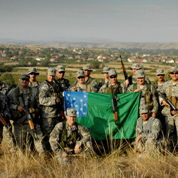 | |
| Use | Civil and war flag |
|---|---|
| Proportion | Approx. 2:3 |
| Adopted | Circa 1776 |
| Design | Green field with a blue canton containing 13 white stars in a "natural pattern" |
The Green Mountain Boys flag, also known as the Stark flag, is a reconstruction of a regimental flag commonly stated to have been used by the Green Mountain Boys. [1] [2] The flag of the Green Mountain Boys has also been associated with the Vermont Republic. [3] A remnant of a Green Mountain Boys flag, originally belonging to John Stark, is owned by the Bennington Museum. [4] It still exists as one of the few regimental flags from the American Revolution. Although Stark was at the Battle of Bennington and likely flew this flag, the battle has become more commonly associated with the Bennington flag, which is believed to be a 19th-century banner. [5] Widely popular with residents of contemporary Vermont, the flag's unusual appearance with randomly placed stars and a bright green field is popularly flown and depicted on stickers, shirts and other items as a symbol of the stubbornly independent spirit of Vermont.
Contents
Today the flag is used as the regimental flag of the Vermont National Guard unit. The regimental flag, known also as a "battle flag" or war flag, accompanies the unit on battle assignments and is physically handed to the commander of the regiment, as described by former Vermont National Guard Adjutant General Martha Rainville in an interview. [6] The flag is also a symbol of the Vermont secessionist movement.[ citation needed ] The Castleton University football team has also featured the flag in its pre-game ceremonies since its inception in 2009.[ citation needed ] Proposals have been considered to change the state flag of Vermont back to the flag of the Green Mountain Boys' design, but none have succeeded. [7]



